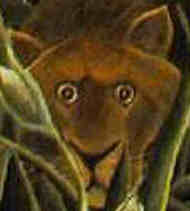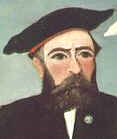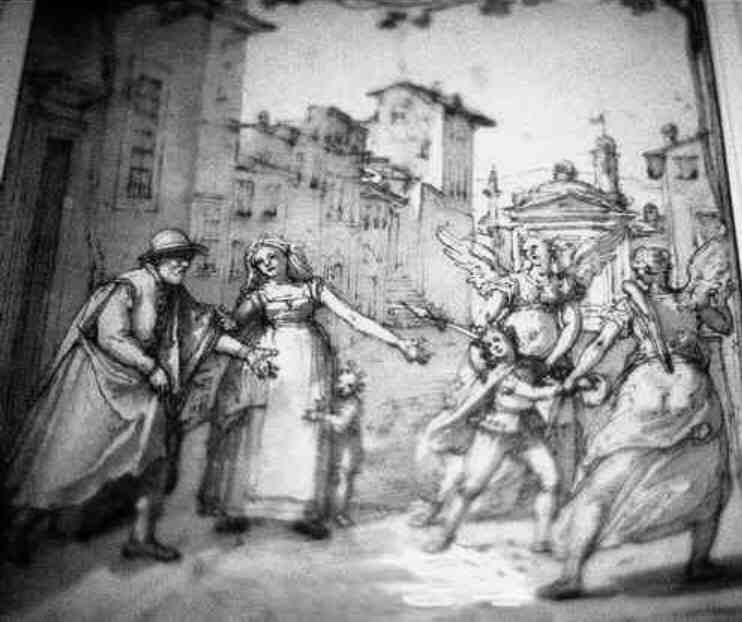
 Died on 02 September 1910Henri
Julien Félix “le Douanier” Rousseau,
French painter born on 21 May 1844. — Not to be confused with Orientalist
painter Henri
Émilien Rousseau [17 Dec 1875 – 28 Mar 1933]
Died on 02 September 1910Henri
Julien Félix “le Douanier” Rousseau,
French painter born on 21 May 1844. — Not to be confused with Orientalist
painter Henri
Émilien Rousseau [17 Dec 1875 – 28 Mar 1933] [click on tiger for LE RÊVE >]
Henri Rousseau was born in Laval in northern France. His nickname refers to the job he held with the Paris Customs Office (1871-1893), although he never actually rose to the rank of "Douanier" (Customs Officer). Before this he had served in the army, and he later claimed to have seen service in Mexico, but this story seems to be a product of his imagination. He took up painting as a hobby and accepted early retirement in 1893 so he could devote himself to art.
Rousseau had been a minor customs employee (percepteur de l'octroi) and did not begin to paint until 1885, at the age of 41. It was in the six or seven years before his death in 1910 that he produced the majority of his exotic landscapes upon which his fame has rested. He called these landscapes with their exuberant trees, flourishing flowers and playful animals, his "Mexican pictures". He thus fostered the romantic belief that in his youth he had served in the army of Maximilian in Mexico. This was not true, and his real inspiration came from the Paris botanical garden and zoo. Rousseau was a strong believer in spirits, the world beyond and interior communication. Contemporaries record how he sometimes became so terrified by the exotic landscapes he was painting, that he would rush to open his window to prevent himself from suffocating. However, his method of creating these scenes was totally controlled. The composition is built in layers of parallel planes, all ordered within the shallow space. Although considered a "primitive," he was greatly admired by the young avant-garde painters including Picasso and Braque.
 His character was extraordinarily ingenuous and he suffered much ridicule
(although he sometimes interpreted sarcastic remarks literally and took
them as praise) as well as enduring great poverty. However, his faith in
his own abilities never wavered. He tried to paint in the academic manner
of such traditionalist artists as Bouguereau and Gérôme, but it was the
innocence and charm of his work that won him the admiration of the avant-garde:
in 1908 Picasso gave a banquet, half serious half burlesque, in his honor.
Rousseau is now best known for his jungle scenes, the first of which is
Surprise!
(Tropical Storm with a Tiger) (1891) and the last Le
Rêve (1910). These two paintings are works of great
imaginative power, in which he showed his extraordinary ability to retain
the utter freshness of his vision even when working on a large scale and
with loving attention to detail. He claimed such scenes were inspired by
his experiences in Mexico, but in fact his sources were illustrated books
and visits to the zoo and botanical gardens in Paris.
His character was extraordinarily ingenuous and he suffered much ridicule
(although he sometimes interpreted sarcastic remarks literally and took
them as praise) as well as enduring great poverty. However, his faith in
his own abilities never wavered. He tried to paint in the academic manner
of such traditionalist artists as Bouguereau and Gérôme, but it was the
innocence and charm of his work that won him the admiration of the avant-garde:
in 1908 Picasso gave a banquet, half serious half burlesque, in his honor.
Rousseau is now best known for his jungle scenes, the first of which is
Surprise!
(Tropical Storm with a Tiger) (1891) and the last Le
Rêve (1910). These two paintings are works of great
imaginative power, in which he showed his extraordinary ability to retain
the utter freshness of his vision even when working on a large scale and
with loving attention to detail. He claimed such scenes were inspired by
his experiences in Mexico, but in fact his sources were illustrated books
and visits to the zoo and botanical gardens in Paris.His other work ranges from the jaunty humor of Les Joueurs de Football (1908) to the mesmeric, eerie beauty of La Bohémienne Endormie (1897). Rousseau was buried in a pauper's grave, but his greatness began to be widely acknowledged soon after his death. He died in Paris.
— Le Douanier Rousseau is the most celebrated of naïve artists. His nickname refers to the job he held with the Paris Octroi Office (1871-93; octroi = entrance fee on merchandise, paid to the municipal authorities, a kind of internal customs), although he never actually rose to the rank of Douanier (Customs Officer). Before this he had served in the army, and he later claimed to have seen service in Mexico, but this story seems to be a product of his imagination. He took up painting as a hobby and accepted early retirement in 1893 so he could devote himself to art. His character was extraordinarily ingenuous and he suffered much ridicule (although he sometimes interpreted sarcastic remarks literally and took them as praise) as well as enduring great poverty. However, his faith in his own abilities never wavered. He tried to paint in the academic manner of such traditionalist artists as Bouguereau and Gérôme, but it was the innocence and charm of his work that won him the admiration of the avant-garde: in 1908 Picasso gave a banquet, half serious half burlesque, in his honor. Rousseau is now best known for his jungle scenes, the first of which is Surprise! (Tropical Storm with a Tiger) (1891) and the last The Dream (1910). These two paintings are works of great imaginative power, in which he showed his extraordinary ability to retain the utter freshness of his vision even when working on a large scale and with loving attention to detail. He claimed such scenes were inspired by his experiences in Mexico, but in fact his sources were illustrated books and visits to the zoo and botanical gardens in Paris. His other work ranges from the jaunty humor of The Football Players (1908) to the mesmeric, eerie beauty of The Sleeping Gypsy. Rousseau was buried in a pauper's grave, but his greatness began to be widely acknowledged soon after his death.
— One artist who prefigured the Surrealists' idea of fantasy with his fresh, naïve outlook on the world was Henri Rousseau. Like Paul Klee, he defies all labels, and although he has been numbered among the Naïfs or Primitives (two terms for untrained artists), he transcends this grouping. Known as “Le Douanier”, after a lifelong job in the Parisian customs office, Rousseau is a perfect example of the kind of artist in whom the Surrealists believed: the untaught genius whose eye could see much further than that of the trained artist. Rousseau was an artist from an earlier era: he died in 1910, long before the Surrealist painters championed his art. Pablo Picasso, half-ironically, brought Rousseau to the attention of the art world with a dinner in his honor in 1908: an attention to which Rousseau thought himself fully entitled. Although Rousseau's greatest wish was to paint in an academic style, and he believed that the pictures he painted were absolutely real and convincing, the art world loved his intense stylization, direct vision, and fantastical images. Such total confidence in himself as an artist enabled Rousseau to take ordinary book and catalogue illustrations and turn each one into a piece of genuine art: his jungle paintings, for instance, were not the product of any first-hand experience and his major source for the exotic plant life that filled these strange canvases was actually the tropical plant house in Paris. Despite some glaring disproportions, exaggerations, and banalities, Rousseau's paintings have a mysterious poetry. Boy on the Rocks is both funny and alarming. The rocks seem to be like a series of mountain peaks and the child effortlessly dwarves them. His wonderfully stripy garments, his peculiar mask of a face, the uncertainty as to whether he is seated on the peaks or standing above them, all comes across with a sort of dreamlike force. Only a child can so bestride the world with such ease, and only a childlike artist with a simple, naïve vision can understand this elevation and make us see it as dauntingly true.
^
— LINKS
— Moi: Portrait~Paysage
— Self-Portrait with a Lamp (1903) — The Painter and His Wife (1899)
— Le Rêve (1910, 204x298cm)
— Surprise! (1891, 130x162cm) _ A tiger stalks through a jungle, its eyes bulging and whiskers upright with terror, presumably at the flash of lightning in the sky. The drama of the moment is enhanced by the strong wind and lashing rain which is applied on top of the painting with a translucent varnish-like material. Rousseau claimed his jungle pictures were inspired during his time in Mexico with the French army. In fact he had never been abroad and had to make his studies of exotic flora and fauna at the botanical gardens in Paris.
— Les Joueurs de Rugby (1908, 1105x881pix)
— La Bohémienne Endormie (1897, 130x201cm) — Boy on Rocks (1897, 55x46cm)
— Éclaireur attaqué par un tigre (1904, 120x162cm)
— Combat Entre Tigre et Buffle I (1908, 883x1056pix)
— Combat Entre Tigre et Buffle II (1908, 46x55cm, 993x1132pix)
— Les Artilleurs (1893, 876x1103pix, 112kb) — La Tour Eiffel (1898)
— Femme se Promenant dans une Forêt Exotique (1905, 100x81cm, 1095x890pix)
— Le Repas du Lion (1907) — La Guerre
— L'Octroi (1895; 1104x889pix, 226kb) — The Tiger Hunt (1896, 909x1106pix)
— Tropical Forest with Apes and Snake (1910; 762x977pix, 173kb)
— Apes in the Orange Grove (1910, 771x1059pix)
— Horse Attacked by a Jaguar (1910) — Woman with an Umbrella in an Exotic Forest (1907)
— Paysage Exotique (1909, 927x851pix) — Jungle avec Lion (1910, 766x952pix)
— Surprise Désagréable (1901) [English title should be: Bare Gets Shock, Bear Gets Shot]
— The Snake Charmer (1907, 964x1083pix) — The Flamingos (1907, 768x1102pix)
— The Little Cavalier, Don Juan (1880, 1104x819pix) — Happy Quartet (1902)
— The Representatives of Foreign Powers Coming to Greet the Republic as a Sign of Peace (1907, 891x1104pix)
— Old Junier's Cart (1908, 824x1110pix) — Joseph Brummer (1909, 116x88cm)
— 103 images at Webshots
